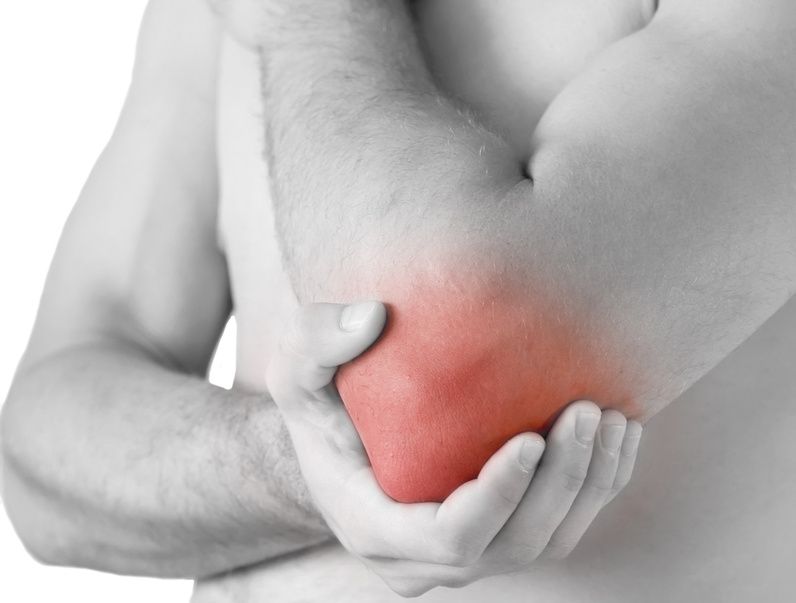One of the causes of the pain caused by bursitis in the elbow is the increased production of synovial fluid. The body fights inflammation by increasing blood flow. The area heats up and reddens. If bacteria are the cause of the inflammation, pus can also develop.
Treatment depends on the cause of the disease. Treatment involves the administration of painkillers and anti-inflammatories, cooling compresses and possibly antibiotics. Short-term immobilisation of the joint with a splint or tape is indicated. In some cases, surgical removal of the bursa is also necessary.
As a rule, bursitis (inflammation of the bursa) as a reaction of the organism to prolonged overstraining, to an injury or to a bacterial infection. In rarer cases, pre-existing underlying diseases trigger the inflammation.
- Pressure overload of the bursa can often be traced back to the constant propping up of the elbow. This posture can irritate the joint so much that it becomes inflamed. This so-called atraumatic inflammation does not result from impacts and injuries, but from long-lasting regular stress.
- Violent impacts in the form of bumps, bruises or sports injuries can trigger the condition. A single strong blow can be enough to cause bursitis.
- If germs reach the bursa, they can cause inflammation. Usually, pus also then forms.
- Inflammation in the joint can also cause bursitis in the elbow. This joint inflammation is often associated with an underlying disease such as rheumatism or gout.
The bursa swells strongly and feels thick and stretchy. There is marked discomfort with high sensitivity to touch and a feeling of tightness. The area of the bursa reacts extremely unpleasantly to pressure. The pain is sudden and intense. The affected area is often overheated and reddened, and the joint is restricted in its movements. In rare cases, the inflammation also spreads beyond the elbow and can lead to swelling of the lymph nodes and reddening of the hands. General symptoms of inflammation such as fever can also occur.

The doctor asks the patient about his or her exercise habits, previous illnesses and exact symptoms. He palpates the painful area on the elbow and checks the joint for range of motion. In most cases, the symptoms and the typical palpation findings already point to an inflammation of the bursa.
In some cases, additional examinations are necessary, for example an ultrasound or an X-ray examination. In an ultrasound examination, the bursa appears as a fluid-filled pocket. If the bursa has thickened edges, this may be a sign of long-standing bursitis.
If there is evidence of purulent inflammation, cannulation is usually performed to confirm or rule out the suspicion of a bacterial infection.
By means of anamnesis, other diseases are ascertained or excluded in order to make the decision for the right treatment approach.
Acute bursitis can also turn into a chronic form, but it is generally easy to treat. In most cases, the earlier the treatment begins, the faster the symptoms disappear. A visit to the doctor is advisable, especially if there are severe signs of illness.
To combat acute inflammation, the doctor mainly prescribes pain-relieving and anti-inflammatory medication, and also prescribes immobilisation of the joint.
Pain relief through medication
Often painkillers like ibuprofen are enough. Depending on how intense the pain is, injection of a local anaesthetic into the joint may be indicated. Cortisone preparations can also be used against severe pain.
Ointment dressings
A poultice or bandage with cooling ointment or tincture helps to relieve pain, reduce inflammation and reduce swelling of the bursa.
Temporary immobilisation
The affected joint is immobilised for a short time with a splint or tape. The arm should not be put under strain. When taping, the special functional bandage allows the joint and muscles not to be completely immobilised, but only to prevent unwanted movements.
Cannulation
Cannulation (puncture) may also be indicated to relieve the swelling.
Antibiotics
If the cause of infection is bacterial, antibiotics are used, among other things to prevent blood poisoning.
Surgery
If conservative measures are unsuccessful, surgery to remove the bursa may be necessary. However, this is only indicated in rare cases.
If the disease does not heal, chronic bursitis develops. This is the case if the bursitis lasts longer than three to six weeks. The operation is a minor surgical procedure (extirpation). Afterwards, the joint must be immobilised. Lymphatic drainage may be necessary.
If an acute bursitis in the elbow is treated in time, it usually heals quickly. The duration of the symptoms is usually a few weeks, after which the symptoms generally disappear. However, if the affected body region continues to be subjected to overload, bursitis can develop again. In the long run, the bursitis in the elbow can have chronic progression.


















